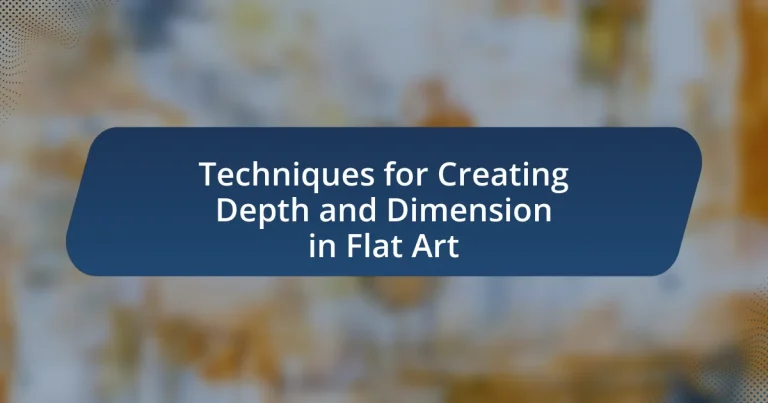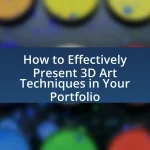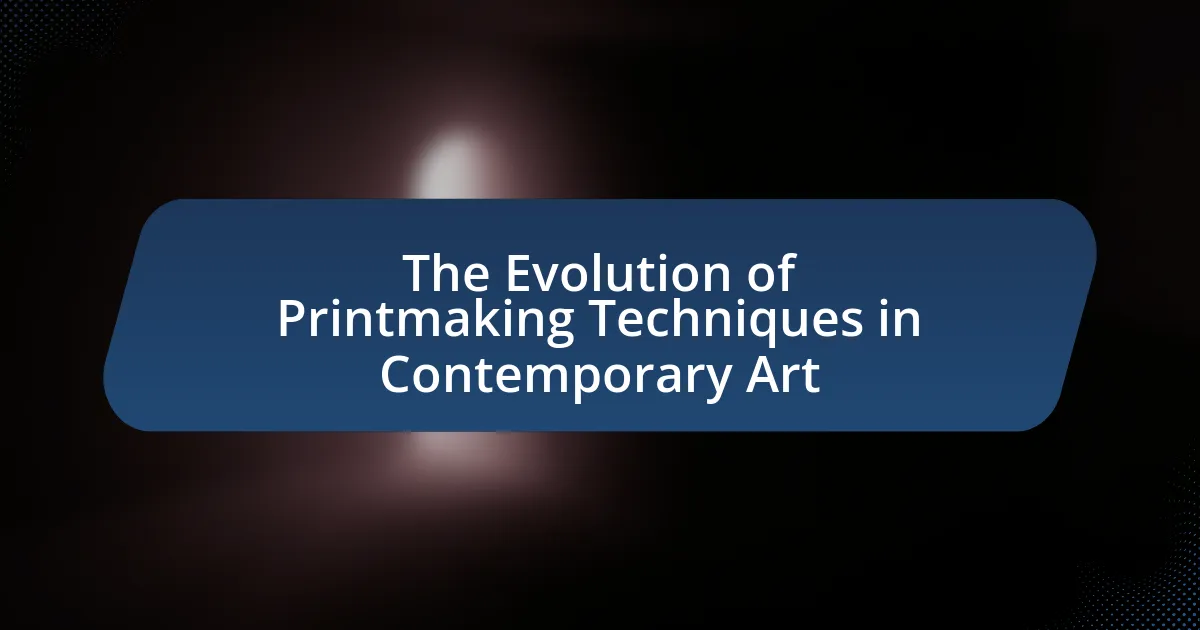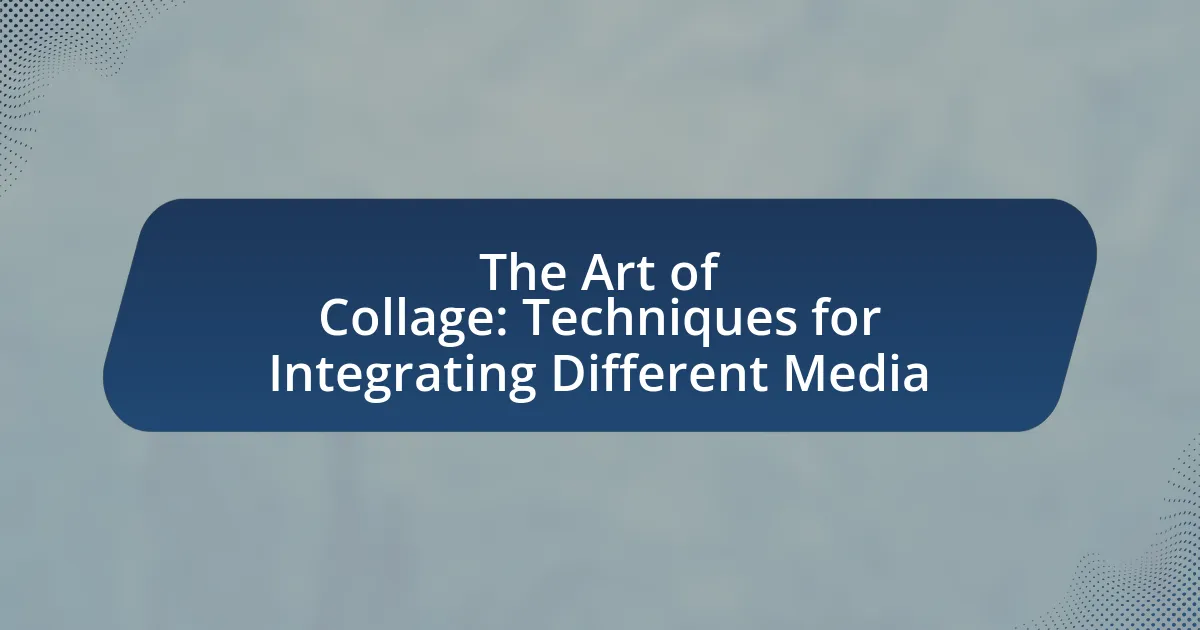The article focuses on techniques for creating depth and dimension in flat art, emphasizing methods such as overlapping elements, varying sizes, atmospheric perspective, and chiaroscuro. It explores how artists achieve depth through linear perspective, color manipulation, and the strategic use of light and shadow. Key elements discussed include the significance of perspective, layering, color theory, and the impact of line and shape on depth perception. Additionally, the article addresses common mistakes to avoid and practical tips for enhancing depth in two-dimensional artworks, providing a comprehensive overview of effective strategies for artists.
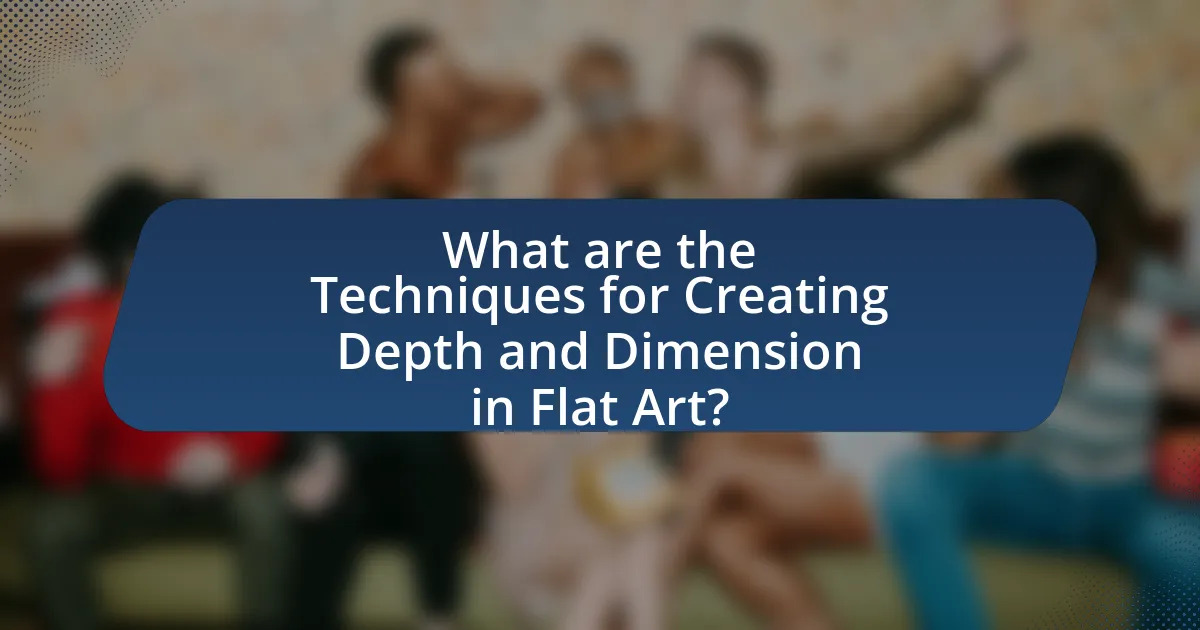
What are the Techniques for Creating Depth and Dimension in Flat Art?
Techniques for creating depth and dimension in flat art include the use of overlapping elements, varying sizes, atmospheric perspective, and chiaroscuro. Overlapping elements create a sense of space by placing one object in front of another, which visually suggests depth. Varying sizes, where larger objects appear closer and smaller ones appear further away, reinforces the perception of three-dimensionality. Atmospheric perspective involves using color and clarity to depict distance; objects in the background are rendered with lighter colors and less detail. Chiaroscuro, the contrast between light and dark, adds volume and form to flat surfaces, enhancing the illusion of depth. These techniques are widely recognized in art theory and practice, as evidenced by their application in works from the Renaissance to contemporary art.
How do artists achieve a sense of depth in two-dimensional works?
Artists achieve a sense of depth in two-dimensional works primarily through techniques such as linear perspective, atmospheric perspective, and the use of overlapping elements. Linear perspective involves creating a vanishing point on the horizon line, where parallel lines converge, giving the illusion of depth; this technique was notably used by artists like Leonardo da Vinci in “The Last Supper.” Atmospheric perspective relies on the gradual fading of colors and details in objects that are further away, mimicking how the human eye perceives distant landscapes, as seen in Claude Monet’s works. Additionally, overlapping elements create a visual hierarchy, where objects in the foreground are placed in front of those in the background, enhancing the perception of space. These methods collectively contribute to a convincing representation of depth in flat art.
What role does perspective play in creating depth?
Perspective is crucial in creating depth as it establishes a spatial relationship between objects in a composition. By utilizing techniques such as linear perspective, where parallel lines converge at a vanishing point, artists can simulate three-dimensional space on a two-dimensional surface. This method effectively guides the viewer’s eye and enhances the illusion of depth, making objects appear closer or farther away based on their placement and size relative to the horizon line. Historical examples, such as the works of Renaissance artists like Leonardo da Vinci, demonstrate how perspective can transform flat art into a convincing representation of reality, thereby validating its role in depth creation.
How can overlapping elements enhance dimensionality?
Overlapping elements enhance dimensionality by creating a sense of depth and spatial relationships within a composition. When one object partially covers another, it establishes a visual hierarchy that guides the viewer’s perception, making the scene appear more three-dimensional. This technique is supported by principles of visual perception, where overlapping shapes are interpreted as being at different distances from the viewer, thus reinforcing the illusion of depth. For instance, in landscape painting, foreground elements that overlap with background elements can effectively convey distance and perspective, as demonstrated in works by artists like Claude Monet, who utilized overlapping forms to create atmospheric depth.
Why is understanding light and shadow important in flat art?
Understanding light and shadow is crucial in flat art because it creates the illusion of depth and dimension, making two-dimensional works appear more three-dimensional. This technique allows artists to guide the viewer’s eye, emphasize focal points, and convey mood or atmosphere. For instance, the use of chiaroscuro, a technique that contrasts light and dark, has been employed since the Renaissance to enhance realism and volume in artwork. By mastering light and shadow, artists can effectively simulate how objects interact with light in the real world, thereby enriching the visual experience for the audience.
What techniques can be used to simulate light and shadow?
Techniques to simulate light and shadow include chiaroscuro, hatching, cross-hatching, and gradient shading. Chiaroscuro involves using strong contrasts between light and dark to create a three-dimensional effect, a method utilized by artists like Caravaggio to enhance depth. Hatching and cross-hatching consist of drawing parallel lines or intersecting lines to indicate shadow and light, a technique commonly seen in pen and ink illustrations. Gradient shading employs a smooth transition between light and dark tones, often used in digital art and painting to create a realistic representation of light sources. These techniques are foundational in art for conveying volume and dimensionality.
How does color influence the perception of depth?
Color influences the perception of depth by creating visual cues that suggest spatial relationships. Warmer colors, such as reds and yellows, tend to appear closer to the viewer, while cooler colors, like blues and greens, often recede into the background. This phenomenon is supported by the concept of atmospheric perspective, where distant objects appear less saturated and more bluish due to the scattering of light in the atmosphere. Research by Paul M. A. van der Helm and colleagues in “Color and Depth Perception” (2015) demonstrates that color contrast can enhance depth perception, as objects with higher color contrast are perceived as more distinct and spatially separated.

What are the Key Elements of Depth and Dimension in Flat Art?
The key elements of depth and dimension in flat art are perspective, layering, color, and light. Perspective creates the illusion of space by using techniques such as linear perspective, where parallel lines converge at a vanishing point, effectively guiding the viewer’s eye and creating a sense of distance. Layering involves the placement of objects in front of or behind one another, which enhances the perception of depth. Color plays a crucial role, as warmer colors tend to advance while cooler colors recede, influencing how depth is perceived. Light and shadow add dimensionality by creating highlights and contrasts that suggest volume and form. These elements work together to create a convincing representation of three-dimensional space on a two-dimensional surface.
How do line and shape contribute to depth perception?
Line and shape significantly contribute to depth perception by creating visual cues that inform the viewer about spatial relationships. Lines can suggest perspective through techniques such as converging lines, which lead the eye toward a vanishing point, thereby enhancing the illusion of depth. Shapes, particularly when overlapped or varied in size, provide context for distance; larger shapes appear closer while smaller shapes seem farther away. Research in visual perception indicates that these elements are fundamental in guiding the brain’s interpretation of three-dimensional space from two-dimensional representations, as evidenced by studies on perspective drawing and visual cognition.
What types of lines are most effective for creating depth?
Diagonal lines are most effective for creating depth in flat art. These lines lead the viewer’s eye into the composition, suggesting movement and perspective. For instance, in landscape paintings, diagonal lines can represent paths or slopes, enhancing the illusion of three-dimensional space. Additionally, converging lines, such as those found in linear perspective, draw the viewer’s focus toward a vanishing point, further reinforcing depth perception. This technique is widely used in classical art, where artists like Leonardo da Vinci employed it to create realistic spatial relationships.
How do geometric shapes affect the viewer’s perception of space?
Geometric shapes significantly influence the viewer’s perception of space by creating a sense of depth and dimensionality. For instance, shapes like rectangles and squares can suggest stability and structure, while triangles can evoke a sense of movement or tension. The arrangement and size of these shapes can manipulate how space is perceived; larger shapes appear closer, while smaller shapes seem farther away. Research in visual perception indicates that the use of overlapping geometric forms can enhance the illusion of depth, as demonstrated in studies by Edward Adelson at MIT, which show how our brains interpret spatial relationships based on shape and positioning. Thus, the strategic use of geometric shapes is essential in flat art to effectively convey three-dimensional space.
What is the significance of color theory in creating depth?
Color theory is significant in creating depth because it utilizes color relationships to influence perception and spatial dynamics in flat art. By employing techniques such as warm and cool color contrasts, artists can simulate depth; warm colors tend to advance while cool colors recede, creating an illusion of three-dimensionality. For instance, a study by the University of California, Berkeley, demonstrated that viewers perceive warmer colors as closer to the viewer, enhancing the sense of depth in a composition. Additionally, the use of color saturation and value can further enhance this effect, as more saturated colors appear to come forward, while desaturated colors recede, reinforcing the spatial hierarchy within the artwork.
How can warm and cool colors be used to create a sense of distance?
Warm and cool colors can be used to create a sense of distance by utilizing the psychological effects these colors have on perception. Warm colors, such as reds and yellows, tend to advance and appear closer to the viewer, while cool colors, like blues and greens, recede and create an illusion of depth. This principle is supported by color theory, which indicates that warm colors can evoke feelings of warmth and proximity, while cool colors are associated with calmness and distance. For example, in landscape paintings, artists often use warm colors in the foreground to draw attention and cool colors in the background to suggest depth and space, effectively guiding the viewer’s eye through the composition.
What are the effects of saturation and value on depth perception?
Saturation and value significantly influence depth perception in visual art. High saturation colors tend to appear closer to the viewer, while desaturated colors recede into the background, creating a sense of depth. Additionally, value, which refers to the lightness or darkness of a color, affects how objects are perceived in space; lighter values can suggest proximity, while darker values can imply distance. Research in color theory supports this, indicating that artists can manipulate saturation and value to enhance the three-dimensionality of flat images, as demonstrated in studies by researchers like Joseph Albers in “Interaction of Color,” which illustrates how color relationships impact perception.

What Techniques Can Be Applied for Effective Depth Creation?
Effective depth creation in flat art can be achieved through techniques such as layering, perspective, and color contrast. Layering involves placing elements at varying distances from the viewer, which creates a sense of foreground, middle ground, and background. Perspective techniques, including linear and atmospheric perspective, help to simulate depth by manipulating the size and clarity of objects based on their distance from the viewer. Additionally, using color contrast, where warmer colors appear to advance and cooler colors recede, enhances the perception of depth. These methods are widely recognized in art education and practice, demonstrating their effectiveness in creating dimensionality in two-dimensional works.
How can layering techniques enhance depth in flat art?
Layering techniques enhance depth in flat art by creating a sense of dimensionality through the overlapping of various elements. This method allows artists to simulate the effects of light, shadow, and perspective, which contribute to a more immersive visual experience. For instance, by applying multiple layers of color or texture, artists can achieve gradients and variations that mimic the natural world, making objects appear closer or further away. Additionally, the use of transparent or semi-transparent layers can introduce complexity and richness, as seen in works by artists like Claude Monet, who utilized layering to convey atmospheric effects. This approach not only adds visual interest but also engages viewers by inviting them to explore the intricacies of the artwork.
What are the best practices for layering different elements?
The best practices for layering different elements in flat art include using varying opacities, contrasting colors, and strategic placement to create depth. By adjusting the transparency of layers, artists can simulate distance and focus, allowing background elements to recede while foreground elements stand out. Utilizing contrasting colors enhances visual interest and helps differentiate layers, making the composition more dynamic. Additionally, placing elements at different angles or positions within the frame can guide the viewer’s eye and establish a sense of three-dimensionality. These techniques are supported by principles of design that emphasize balance and hierarchy, ensuring that layered elements contribute to a cohesive overall composition.
How does transparency affect the perception of depth?
Transparency influences the perception of depth by allowing viewers to see layers and objects behind transparent surfaces, creating a sense of spatial relationships. When an object is transparent, it can distort the appearance of objects behind it, leading to a visual cue that enhances depth perception. Research indicates that transparency can enhance depth cues such as overlap and relative size, as demonstrated in studies where participants reported greater depth perception in images featuring transparent elements compared to opaque ones. This effect is supported by findings in visual perception literature, which show that transparency can manipulate how depth is interpreted in two-dimensional art, making it a valuable technique for artists aiming to create a three-dimensional feel in flat artworks.
What are some common mistakes to avoid when creating depth?
Common mistakes to avoid when creating depth include neglecting perspective, overusing outlines, and failing to vary color saturation. Neglecting perspective can lead to unrealistic spatial relationships, making objects appear flat. Overusing outlines can flatten forms, reducing the illusion of three-dimensionality. Failing to vary color saturation can result in a lack of visual interest and depth, as colors that are too uniform do not convey distance effectively. These mistakes hinder the overall effectiveness of depth in flat art.
How can artists troubleshoot issues with depth perception in their work?
Artists can troubleshoot issues with depth perception in their work by employing techniques such as atmospheric perspective, overlapping elements, and adjusting scale. Atmospheric perspective involves using color and clarity to create the illusion of depth; for instance, distant objects appear lighter and less detailed. Overlapping elements can enhance depth by positioning objects in front of one another, clearly defining spatial relationships. Additionally, adjusting the scale of objects relative to one another can create a sense of distance; larger objects appear closer while smaller ones seem further away. These methods are supported by principles of visual perception, which indicate that our brains interpret depth cues based on these visual strategies.
What practical tips can artists use to improve depth in their flat art?
Artists can improve depth in their flat art by utilizing techniques such as atmospheric perspective, layering, and contrasting values. Atmospheric perspective involves using color and clarity to create the illusion of distance; for example, objects in the background are depicted with lighter, less saturated colors. Layering adds depth by overlapping elements, which creates a sense of foreground and background. Additionally, contrasting values—using a range of light and dark tones—can enhance the three-dimensionality of shapes, making them appear more dynamic and realistic. These methods are supported by principles of visual perception, which indicate that our brains interpret depth through color, overlap, and contrast.
